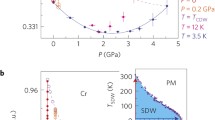Abstract
Calculations of dipole correlations and internal-energy densities are reported for dilute dipole systems in the NaCl and CsCl lattices. The tensorial dipole interaction potential is used in thermal averaging in a two-dipole approximation. Actual lattice geometries are taken into account in the three-dimensional spatial averages. The dipoles are assumed to have equilibrium orientations along [100] in the NaCl lattice, and along either [100] or [111] in the CsCl lattice. It is found thatlocal antiparallel ordering is favored in both lattices at low temperatures. Comparison with recent, low-temperature dielectric data indicates that relaxation mechanisms are as important as local antiparallel ordering in limiting theT −1 increase of (ɛ−1)/(ɛ+2) with decreasing temperature for OH− doped KCl. A simplified, nonequilibrium mechanism is studied whereby parallel-correlated dipoles with interaction energies greater than2 kT in absolute value become nonalignable and do not contribute toɛ. This mechanism together with antiparallel ordering are found to describe the experimental data satisfactorily; but additional relaxation mechanisms are indicated.
The contribution of the dipole interactions to the specific heat is also calculated, and is in qualitative agreement with measured specific heat data for OH− doped KCl.
Résumé
On a calculé les corrélations dipolaires et la densité de l'énergie interne pour les systèmes dilués de dipôles distribués statistiquement dans les réseaux du type NaCl et CsCl aux endroits des anions. On a supposé que les dipôles ne peuvent s'orienter que suivant l'axe [100] pour le NaCl et l'axe [111] ou [100] pour le CsCl. Le calcul des valeurs thermiques moyennes est basé sur l'approximation à deux dipôles où l'on a utilisé la dépendance angulaire correcte de l'interaction.
On trouve pour les deux types de réseaux unepréférence pour l'arrangement local antiparallel à basses températures. La confrontation de la fonction diélectrique dépendante de la température aux données expérimentales du KCl:KOH démontre qu'un arrangement antiparallel local n'explique que partiellement les différences entre les mesures de (ɛ−1)/(ɛ+2) et la loiT −1. L'accord est meilleur si l'on suppose que les paires dipolaires couplées parallèlement à énergie d'interaction supérieure à2kT sont „gelées” et ne contribuent pas à la fonction diéléctrique.
On a calculé la contribution de l'interaction dipolaire à la chaleur spécifique et on a constaté un accord qualitatif avec les données expérimentales du KCl:KOH.
Zusammenfassung
Die Dipol-Korrelationen und die Dichte der inneren Energie wurden berechnet für verdünnte Systeme von Dipolen, welche statistisch auf die Anionenplätze in Gittern vom NaCl-und CsCl-Typ verteilt sind. Es wurde angenommen, daß sich die Dipole im NaCl-Gitter nur längs [100]-Achsen und im CsCl-Gitter längs [111]- oder [100]-Achsen einstellen können. Die Berechnung der thermischen Mittelwerte beruht auf der Zwei-Dipol-Approximation, wobei die korrekte Winkelabhängigkeit der Wechselwirkung eingesetzt wurde.
Man findet für beide Gittertypen, daß bei tiefen Temperaturenlokale antiparallele Ordnung bevorzugt ist. Die berechnete Temperaturabhängigkeit der dielektrischen Funktion wurde verglichen mit den experimentellen Daten für KCl:KOH. Es zeigte sich, daß die antiparallele lokale Ordnung die experimentell gefundene Abweichung der Größe (ɛ−1)/(ɛ+2) vomT −1 Gesetz nur zum Teil erklärt. Bessere Übereinstimmung mit dem Experiment wird erhalten, wenn man zusätzlich annimmt, daß die ebenfalls vorhandenen parallel gekoppelten Dipol-Paare mit Wechselwirkungsenergien größer als2 kT „eingefroren” sind und nicht mehr zur dielektrischen Funktion beitragen.
Der berechnete Beitrag der Dipolwechselwirkung zur spezifischen Wärme ist in qualitativer Übereinstimmung mit experimentellen Daten für KCl:KOH.
Similar content being viewed by others
References
Känzig, W., H. R. Hart, andS. Roberts: Phys. Rev. Letters13, 543 (1964).
Sack, H. S., andM. Moriarity: Bull. Amer. Phys. Soc.10, 348 (1965).
Narayanamurti, V.: Phys. Rev. Letters13, 693 (1964).
——, andR. O. Pohl: Bull. Amer. Phys. Soc.10, 616 (1965).
Kuhn, U., andF. Lüty: Solid State Comm.3, 31 (1965).
Patterson, D. A.: Bull. Amer. Phys. Soc.10, 474 (1965).
Lombardo, J., andR. O. Pohl: Bull. Amer. Phys. Soc.10, 617 (1965); Phys. Rev. Letters15, 291 (1965).
Fröhlich, H.: Theory of dielectrics, 2nd Ed., London: Oxford Univ. Press, 1957.
Zernik, W.: Phys. Rev.139, A 1010 (1965).
Brout, R.: Phys. Rev. Letters14, 175 (1965).
Bosshard, U., R. W. Dreyfus, andW. Känzig: Phys. kondens. Materie4, 254 (1965).
Shepherd, I., andJ. Feher: Phys. Rev. Letters15, 194 (1965).
Brout, R.: Phys. Rev.115, 824 (1959).
Klein, M. V.: Phys. Rev.141, 489 (1966).
Author information
Authors and Affiliations
Rights and permissions
About this article
Cite this article
Lawless, W.N. Impurity dipole interactions in alkali halides at low temperature. Phys kondens Materie 5, 100–114 (1966). https://doi.org/10.1007/BF02422730
Received:
Issue Date:
DOI: https://doi.org/10.1007/BF02422730




